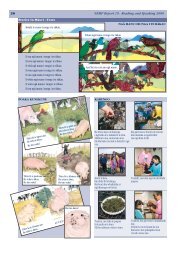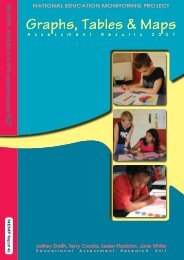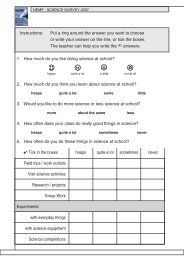mathematics
Mathematics 2001.pdf [33.7 MB] - NEMP - University of Otago
Mathematics 2001.pdf [33.7 MB] - NEMP - University of Otago
- No tags were found...
You also want an ePaper? Increase the reach of your titles
YUMPU automatically turns print PDFs into web optimized ePapers that Google loves.
12 chapter 3<br />
Number<br />
The assessments included thirty-five tasks investigating students’ understandings,<br />
processes and skills in the area of <strong>mathematics</strong> called number. Number includes<br />
the ways numbers are represented, their value, operations on number, accuracy<br />
and efficiency in calculating, estimating and making approximations.<br />
Twelve tasks were identical for both year 4 and year 8. Thirteen tasks had overlapping<br />
versions for year 4 and year 8 students, with some parts common to both<br />
levels. Seven tasks were attempted by year 8 students only, and three by year 4<br />
only. Eight are trend tasks (fully described with data for both 1997 and 2001),<br />
fifteen are released tasks (fully described with data for 2001 only), and twelve are<br />
link tasks (to be used again in 2005, so only partially described here).<br />
The tasks are presented in the three sections: trend tasks, then released tasks and<br />
finally link tasks. Within each section, tasks attempted (in whole or part) by both<br />
year 4 and year 8 students are presented first, then tasks where year 4 and year 8<br />
students did parallel tasks, followed by tasks attempted only by year 8 students.<br />
Averaged across 229 task components administered to both year 4 and year 8<br />
students, 25 percent more year 8 than year 4 students succeeded with these components.<br />
Year 8 students performed better on every component. As expected, the<br />
differences were generally larger on more difficult tasks — often tasks that many<br />
year 4 students would not yet have had much opportunity to learn in school.<br />
There was evidence of modest improvement between 1997 and 2001, especially<br />
for year 4 students. Averaged across 59 trend task components attempted by year 4<br />
students in both years, 5 percent more students succeeded in 2001 than in 1997.<br />
Gains occurred on 51 of the 59 components. At year 8 level, with 106 trend task<br />
components included, 3 percent more students succeeded in 2001 than in 1997.<br />
Gains occurred on 85 of the 106 components.<br />
Students at both levels scored poorly in tasks involving estimation and tasks involving<br />
fractions (especially fractions other than halves and quarters). Asked to work<br />
on computations such as 36 + 29 or 9 x 98, few students at both levels chose the<br />
simplification of adjusting one of the numbers to a more easily handled adjacent<br />
number (making the 29 into 30, or the 98 into 100). Most relied instead on the<br />
standard algorithms for these tasks, indicating a lack of deep understanding of<br />
number operations. The following percentages of year 8 students got ninety percent<br />
or more of tested basic facts correct: 99 percent for addition, 95 percent for<br />
subtraction, 86 percent for multiplication, and 65 percent for division. For year 4<br />
students, the corresponding percentages were 84 percent, 53 percent, 26 percent,<br />
and 11 percent.






